ROCHEFORT-EN-TERRE, A ‘PLUS BEAU VILLAGE DE FRANCE’
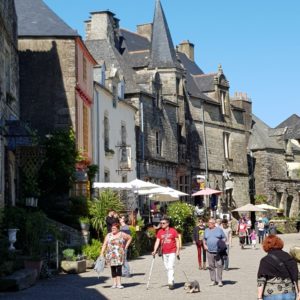
Sitting high on a rocky promontory above the valley of Gueuzon and the River Arz, Rochefort-en-Terre is a village in the countryside of the Morbihan departement of south-west Brittany. Not only classified as one of the ‘Plus Beau Villages de France’ it has also been designated a ‘Petite Cité de Caractére’ and a ‘Ville Fleurie’, making it one of the Brittany’s most visited sites. As well as the charm of the village itself, there is also a medieval chateau on the edge of town. It was not surprising that Rochefort-en-Terre was voted by the French themselves in 2016 as their favourite village of the year.
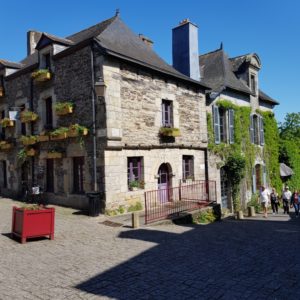
The entire village is intact, and based around a picture-perfect central square lined on all sides with beautiful houses, mostly dating from the 17th century, although a considerable number are much older. The mix of colombage (timbered) and granite construction of the medieval and Renaissance buildings is very harmonious despite the different styles and periods of architecture, and sufficient reason alone to visit Rochefort-en-Terre.
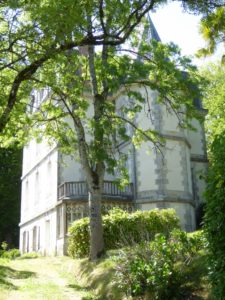
The Chateau de Rochefort-en-Terre, which originally dated back to the 12th century, was badly damaged by fire in the 1800s, although the façade remained intact. The chateau was bought by an American painter, Alfred Klotz in 1907, who set about totally restoring the entire complex. His son, also a painter, inherited the chateau and it became a very popular destination for fellow artists. Upon his death, his widow gifted the chateau to the French government.
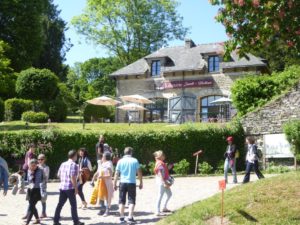
It is open to the public during the summer months, although the grounds are open all year and free to enter. As the gardens and park around the chateau are on a rise, visitors can enjoy the panoramic views over the village and surrounding countryside from its elevated position.
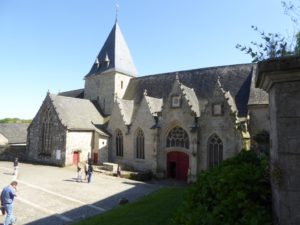
The village church of Notre-Dame-de-la-Tronchaye, sitting one street lower down from the main street, dates from the 12th century, and built using the local dark granite. The 16th century alterations were in the flamboyant Gothic style, so the building has quite an unusual design in both the exterior and interior.
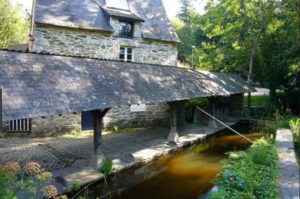
The village also still has its traditional lavoir—the ancient public laundry area—which is also a designated historic monument.
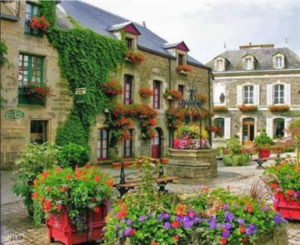
Alfred Klotz and his son encouraged the villagers to attach window boxes planted with geraniums onto the facades of their houses and install many planter boxes full of flowers in the streets. This ongoing tradition of private and public floral displays softens the hardness of the granite buildings, and of course, adds to the considerable charm of the village. For much of the summer, all the streets of the village are illuminated during the evenings, making it even more picturesque—and photogenic!

Not so long ago, the village was slowly dying and its young people were having to move away to find work. Nowadays it is no longer a village in decline. Although it survives mostly on income generated from tourism-related activities, nevertheless the village is still populated with local people, who operate the numerous cafes, small hotels, art galleries, artisan ateliers and workshops. Some of the now-thriving local crafts that had almost died out include potters, candle makers, toy-makers and incredible artisan biscuit makers.
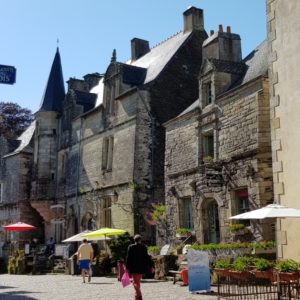
We stayed overnight right on the main square in a beautiful granite 16th century hotel, ‘La Tour du Lion’, complete with its own tower, that has a very good restaurant in-house which is set up in the rear courtyard in fine weather. If you plan on staying here, just be aware that access to the rooms on upper floors is via a very narrow, steep spiral staircase, which came as something of an unwelcome surprise. Luckily for us, they were able to offer us a ground floor room overlooking the courtyard, which was spacious and very comfortable, beautifully decorated, including a four-poster bed, with some antique pieces for atmosphere—note though that there’s no TV in the rooms. Just remember when booking to ask for a ground floor room!
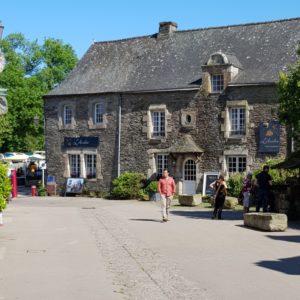
As traffic is banned during the day until around 7.00pm, it necessitates carrying one’s luggage from the large communal carpark into the village. However, cars may enter the village until around 9.00am in the mornings, making it easy to load luggage on check-out. None of this is a problem if you’re forewarned, and indeed, it’s a pedestrian’s delight to stroll around the village without dodging vehicles.
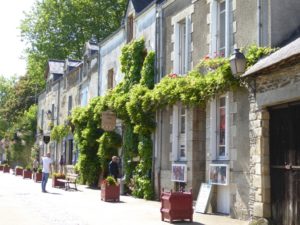
When one thinks of Brittany it’s more likely that coastal villages and ports with their dramatic seascapes, lighthouses and fortifications come to mind, but a stop-over in this beautiful little village is sure to be a highlight of an exploration of Brittany.
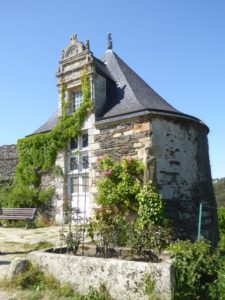


Lovely article and great tips re the hotel stairs and access- definitely the little things that are so good to know that would make a visit so much more enjoyable.
Another one to add to the long list….
It was a great place to stay–probably the best in town–full of atmosphere and beautifully decorated, but that staircase would’ve challenged most guests, I’d say!
Looks, and sounds wonderful. One for the bucket list.
I agree! Our own list just keeps on growing…!
A very interesting article and certainly one to remember for the future.
Hi Joy,
It’s these unexpected gems that really are such a bonus.
Fun reading for a sunday morning.
Hi Angela,
Glad you enjoyed it. There are so many quaint little surprises like this to be found in Brittany!